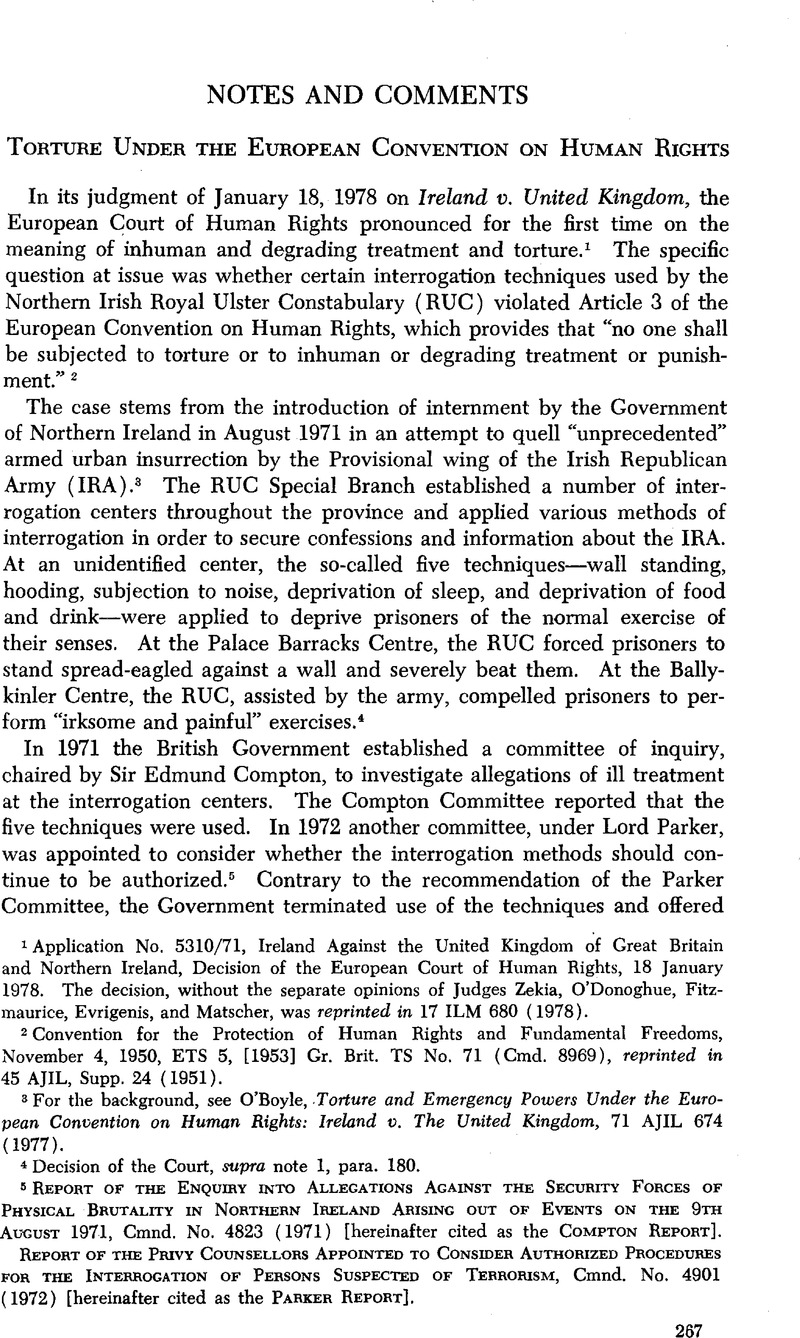Published online by Cambridge University Press: 27 February 2017

1 Application No. 5310/71, Ireland Against The United Kingdom of Great Britain and Northern Ireland, Decision of The European Court of Human Rights, 18 January 1978. The decision, without The separate opinions of Judges Zekia, O'Donoghue, Fitzmaurice, Evrigenis, and Matscher, was reprinted in 17 ILM 680 (1978).
2 Convention for The Protection of Human Rights and Fundamental Freedoms, November 4, 1950, ETS 5, [1953] Gr. Brit. TS No. 71 (Cmd. 8969), reprinted in 45 Ajil, Supp. 24 (1951).
3 For The background, see O'Boyle, Torture and Emergency Powers Under The European Convention on Human Rights: Ireland v. The United Kingdom, 71 Ajil 674 (1977).
4 Decision of The Court, supra note 1, para. 180.
5 Report Of The Enquiry Into Allegations Against The Security Forces Of Physical Brutality In Northern Ireland Arising Out Of Events On The 9TH August 1971, Cmnd. No. 4823 (1971) [hereinafter cited as The compton report]. report of The privy counsellors appointed to consider authorized procedures for The interrogation of persons suspected of terrorism, Cmnd. No. 4901 (1972) [hereinafter cited as The Parker Report].
6 The Prime Minister, Mr. Heath, in 1972 replied to a parliamentary question concerning The legal position of The soldiers who used The five techniques by saying that it was inappropriate to comment on a matter which would be brought before The courts. 832 PAHL. DEB., H.C., at col. 745 ( 2 March 1972).
7 Application No. 5310/71, Ireland V. The United Kingdom, Report of The Commission, at 402. The Commission's report on The torture issue is examined in O'Boyle, supra note 3.
8 Article 26 provides: “The Commission may only deal with The matter after all domestic remedies have been exhausted, according to The generally recognised rules of international law, and within a period of six months from The date on which The final decision was taken.” Although The rule of exhaustion of domestic remedies applies to both individual and interstate applications, it has only limited application in The latter cases. Where The measure alleged to violate a human right is a legislative measure or administrative practice, domestic remedies for redress are by law or administration thereof precluded. There is, accordingly, no need for The applicant to exhaust The domestic remedies. First Cyprus case, 2 Y.B. European convention on human rights 182, 184 (1958); The Greek Case, id. 690, 726.
9 Decision of The Court, supra note 1, para. 154. In The De Becker case (5 Y.B. EUROPEAN CONVENTION ON HUMAN RIGHTS 320 (1962)), The applicant, De Becker, notified The Commission that he wished to withdraw his application from proceedings before The Court. The Court ruled that De Becker's decision not to pursue his application did not render The case moot because its judgments elucidate safeguards embodied in The convention. The Court cited as authority Article 19 of The convention and Rule 47 of The Rules of Court. Strictly speaking, The applicant, De Becker, was not a party before The Court and his notification addressed to The Commission could not be binding upon it or The Court, whereas in Ireland v. The United Kingdom The British Government was a party before The Court. Thus, The Court's decision to examine The torture issue extends The role in De Becker and excludes The notion that The parties’ stipulation to an issue thereby renders it moot. The present case was further distinguished from De Becker in that The British Government gave its solemn undertaking not to reintroduce The five techniques, and was therefore obliged by international law to so refrain. Northern Cameroons case, [1963] ICJ Rep. 15; Nuclear Tests (Australia v. France), [1974] ICJ Rep. 253; and Nuclear Tests (New Zealand v. France), [1974] ICJ Rep. 457. The Court noted The undertaking, but for purposes of The convention held it was obliged to decide The issue.
10 See note 9 supra.
11 Decision of The Court, supra note 1, para. 167.
12 “[I]t appears … that it was The intention that The Convention, with its distinction between ‘torture’ and ‘inhuman or degrading treatment,’ should by The first of these terms attach a special stigma to deliberate inhuman treatment causing very serious and cruel suffering.” Ibid.
13 Compton Report, supra note 5, para. 105; Parker Report, supra note 5, para. 9.
14 Commission Report, supra note 7, at 402.
15 Decision of The Court, supra note 1, para. 167.
16 Id. at 85-86, 90-91.
17 Id. at 119-20.
18 “It aims, by means of new forms of suffering having little in common with bodily pain caused by conventional torments, to provoke, be it only temporarily, The disintegration of The human personality, The destruction of man's mental and physical equilibrium and The annihilation of his will.” Id. at 118.